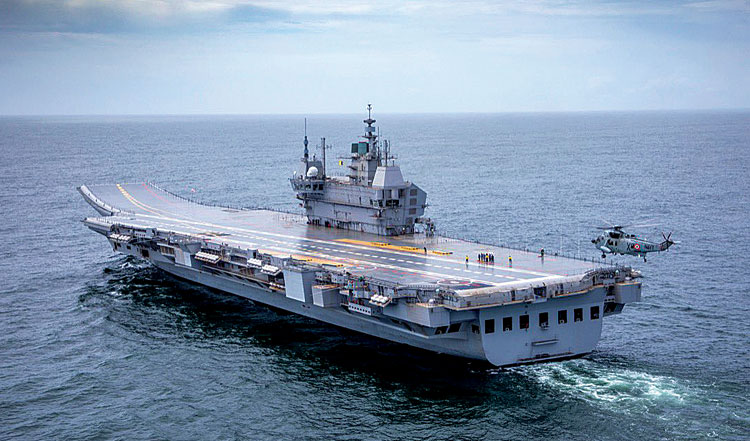INDIAN ARMED FORCES CHIEFS ON OUR RELENTLESS AND FOCUSED PUBLISHING EFFORTS

The insightful articles, inspiring narrations and analytical perspectives presented by the Editorial Team, establish an alluring connect with the reader. My compliments and best wishes to SP Guide Publications.

"Over the past 60 years, the growth of SP Guide Publications has mirrored the rising stature of Indian Navy. Its well-researched and informative magazines on Defence and Aerospace sector have served to shape an educated opinion of our military personnel, policy makers and the public alike. I wish SP's Publication team continued success, fair winds and following seas in all future endeavour!"

Since, its inception in 1964, SP Guide Publications has consistently demonstrated commitment to high-quality journalism in the aerospace and defence sectors, earning a well-deserved reputation as Asia's largest media house in this domain. I wish SP Guide Publications continued success in its pursuit of excellence.
- MoD initiates comprehensive review of Defence Acquisition Procedure 2020, pushes for defence reforms
- G7: The Swansong
- Kalinga Connect: South Asia to Polynesia
- Advanced MRSAM for India for a greater firepower
- Must Credit DRDO for Operation Sindoor, now what is next for defence R&D?
- Operation Sindoor | Day 2 DGMOs Briefing
- Operation Sindoor: Resolute yet Restrained
AIRCRAFT CARRIERS
SCOD Recommendation for Three Aircraft Carriers
Two formidable battle groups centered around aircraft carriers offer the ability to support land operations, shift theatre as the situation may demand and choke points during prolonged operations.
 | The Author is former Chief of Integrated Defence Staff. A naval aviator of fighter stream, he has flown over 2700 hours and steered naval aviation acquisition as the Assistant Chief of Naval Staff. He retired in 2014 as the Flag Officer Commanding-in-Chief of the Western Naval Command. |

In a recent report to the government, the Standing Committee of Defence (SCOD) of the parliament has suggested that the Indian Navy’s projection for three carrier Navy is indispensable. Though it will be the decision of the government whether it can invest in aircraft carrier at present given the state of economy which is in the process of remarkable recovery post pandemic.
Issue of aircraft carriers have always evoked debate, not only in India but elsewhere in the world. These always result in two clear opinions, namely Ayes and Naysayers. In the middle of these two the government of the day has to weigh its decision based on the security environment projections over next five to ten years and the trajectory of economy particularly now at the time of post pandemic recovery.
Importance of Indo-Pacific Region
Emerging threat in the coming decade is in the Indian Ocean, which is India’s lifeline for prosperity. It has been buttressed further by ‘Atmanirbhar’ Bharat call by the Prime Minister. To large extent security concerns of Indian government was reflected in the speech of PM to the UNSC in August 2021 during India’s presidency of the Council where his entire emphasis was on role of seas for prosperity of the world and how security of these Sea Lanes of Communication was essential to meet the future goals.
Government intent is also reflected in the bilateral agreements that India has sighed over last seven years in which Maritime Security has been most prominent.
India has its own serious challenges in the Indian Ocean Region. Maritime threats have accentuated post collusion of Pakistan and China. There are reports of likely transfer of Chinese Aircraft Carrier Liaoning to Pakistan Navy.
India’s own Indo Pacific document, constitution of a separate division in the MEA, joining the Quad, 2+2 ministerial agreements with the US, Australia, France, Japan (possibly) and now Russia in the pipeline are nothing but aggregate of India’s Maritime focus by Modi Government. Sea blindness was often spoken by strategists being India’s bane. Under the colonial rule India was reminded of Mughal invasion through the mountain passes in the north and northwest. These threats & insecurity from land borders was accentuated by arbitrary lines drawn to define India’s borders by the colonizers. India was born with troubled land border in the north and West. It only justified sea blindness. India virtually remained boxed in the land framework without looking beyond the shores which had much room to expand for prosperity. PM Modi’s arrival has changed all that. While land border security challenge will remain as they exist, seas offer India the necessary room to expand her trade and commerce and resultantly prosperity of the country. If our Human Development Index has to improve and get into double digits (presently India is at 146 out of approximately 200 countries in the world), it is important that our economy grows which will facilitate investments in sectors such as infrastructure, education and healthcare.
Cooperative Mechanism
Very early in his innings PM Modi announced his intention of SAGAR (Security and Growth for All in the Region) and Act East. One look at the world map makes it obvious that India’s geography has blessed it with vast areas of sea which need to be exploited for prosperity. India with largest population, GDP and military power in the IOR positions it in a leadership role. The government has made hinterland infrastructure & port development its prime agenda in the SAGARMALA project which has the potential to catapult India in the league of top three economies of world. Maritime issues have found extremely important space in India’s foreign policy discourse. This is one of the important achievements of the government.

With the growth of trade and commerce associated are the security concerns. Geopolitics is undergoing massive churn. Rise of China and relative withdrawal of the US into a shell has the potential of robbing the US of its unipolar stature and rewriting the world order. If anything, Corona pandemic has accelerated this process. It is Asia and Indo Pacific where the new great game is unfolding. Taliban takeover of Afghanistan, resultant push by China to its BRI project to connect Eurasia and it aggressive behavior in the South China Sea are geostrategic alterations underway. In this contest for supremacy between US and China, India must create its place in the world. Time is here and now.
Challenges at Sea for India
While land border security situation is unlikely to ease, it is the ocean which gives India the space to grow and improve its standing in the world. Economy needs to grow rapidly @ 9-10 per cent per year for India to prosper and also ensure it land and maritime security. These are essential for our development, improvement in living standards, education, healthcare etc each one requiring creation of infrastructure. This points at security of Sea Lanes of Communication over which flows our trade. Commerce as much as security calls for cooperative mechanisms with other countries who share the seas. No one country can have assets to ensure desired security over vast spaces of the Indo Pacific. Cooperative arrangements such as QUAD and AUKUS are need of the hour.
India has its own serious challenges in the Indian Ocean Region. Arabian Sea and Southern Indian Ocean are live maritime theatre of India whereas the Bay of Bengal is simmering. Maritime threats have accentuated post collusion of Pakistan and China. The two names have become synonymous. Every weapon system in the Pakistani inventory is if Chinese origin. One of the four frigates has been commissioned, induction of submarines (eight of them) has commenced. There are reports of likely transfer of Aircraft Carrier Liaoning to PN. The Pakistan submarines are expected to have Air Independent propulsion, which give these boats longer endurance underwater without having to surface for charging the batteries. This offers PN opportunity of conducting underwater operations in Grey zone for prolonged durations. On the eastern seaboard Chinese presence is on the increase with more and more crude being offloaded in Myanmar for refining facilities in Kunming.
Every war fighting asset, whether sea based or land based, can be targeted either by conventional weapons or hypersonic weapons. It does not imply that a country should not acquire military power.
India has active two and half fronts at sea. Bay of Bengal (comprising of choke points Straits of Malacca, Sunda and Lombok Straits), Arabian Sea (comprising of Gulf, Straits of Hormuz, Gulf of Aden with traffic emerging from Red Sea, Madagascar Channel & Cape of Good hope) and lastly Southern Indian Ocean comprising of Mauritius, Seychelles, Maldives & SLOC South America- Malacca Strait. The SLOCS criss cross the entire Indian Ocean which run the risk of interdiction in times of conflict with two nuclear weapon states in cohort. Given this threat scenario, two formidable battle groups centered around aircraft carriers are inescapable. It offers the Commanders at sea the ability to support land operations, shift theatre as the situation may demand, deploy to island territories and choke points during prolonged operations. There has been debate on vulnerability of these platforms at sea, it must be appreciated that every war fighting assets, whether sea based or land based, can be targeted either by conventional weapons or hypersonic weapons. It does not imply that a country should not acquire military power. The crunch of funds may lead to staggered acquisition but certainly not giving up assets around which credible battle fleets are formed.
Our parliamentarians of the SCOD need to be complemented for their farsighted assessment of emerging threats and platforms/firepower needed for credible maritime security in the Indian Ocean and littoral.





